When purchasing a long-awaited plant, we always look forward to the first flowers. But then a month passes, the second third, and the violet does not please with abundant flowering, let's try to figure it out and understand how to care for violets.
Material Content:
Violet Growing Requirements

For the growth and development of each plant, certain conditions are necessary. For violets, light is of paramount importance. In rooms with insufficient lighting, violets can die.
If the apartment has enough windows, then you need to choose where the light is soft, diffused. Southern windows should be used with caution, as direct sunlight is contraindicated in violets. In this case, the windows can be covered with short curtains or sheets of white paper.
How to pick up a pot?

Indoor violets are small compact plants, and even varieties with plentiful foliage have a small root system, therefore, the capacity for the plant requires a small one. Senpolia poorly grow and develop in large pots. The optimal container size for young plants should be 5-6 cm. For an adult violet, a pot of 10-12 cm will be sufficient.
Correct soil
A mixture of soil for violets is in every specialized store, but it is not always of high quality.
Since these plants need an acidic substrate, the following components must be present in the composition:
- Sheet earth -5 parts;
- Peat-3 parts;
- Sphagnum, charcoal -10% of the total mass;
- Coarse river sand - 1 part
Florists with experience recommend adding perlite to peat, it will help retain moisture in light soil.
Violet care at home

Caring for indoor violets is not difficult, you just need to follow certain conditions of detention and properly care for the plant.
Illumination and temperature
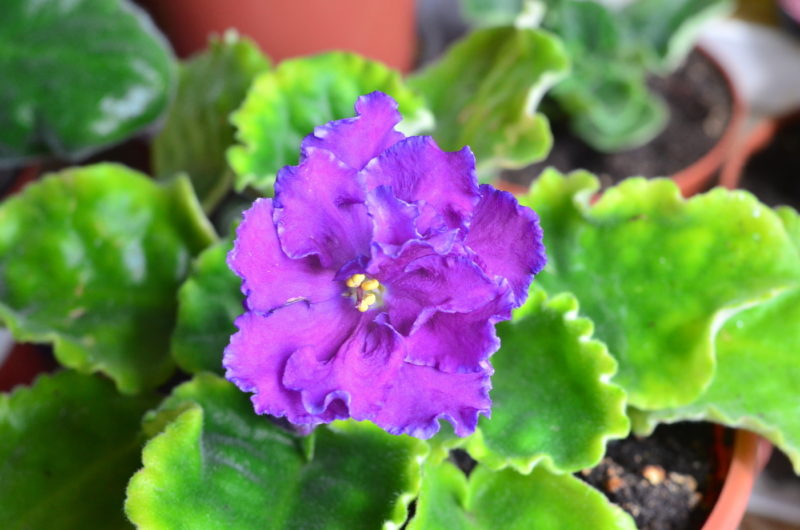
The violet is put on a well-lit place where direct sunlight does not fall. It should be noted that violets with dense, dark green foliage need more light than a plant with light, wavy leaves. It is also not advisable that the plants touch the window glass. If the daylight is short and is less than 15-16 hours, then the flowers provide artificial lighting with a fluorescent lamp.
In summer, the comfortable temperature for violets should be about 20-24 ° C, in the autumn and winter months about 18 ° C.
Watering and feeding violets
The plant is watered as the soil dries up, settled water at room temperature.
Several methods of watering are acceptable for violets:
- Water is poured into the pan;
- A container with a flower is immersed in water for one hour;
- If the house is too hot, more than +25 ° C can be watered from above, but so that water does not fall on the leaves.
Violets do not like spraying, but need moist air. To do this, next to the plant set a saucer with wet expanded clay or sand.
Violets are fed several times during the year. In spring and autumn, they make mineral fertilizer twice, in winter they use organic matter once. In the summer period, if you do not need to feed the plant in good condition, in other cases, use complex fertilizer for violets, which is in every horticultural store. To avoid burns, fertilizers must be diluted in more water than indicated on the package, and top dressing should only be done on moist soil.
Propagation of violets
The most favorable time for breeding senpolia is spring and summer. For this, healthy leaflets of the second row from an adult plant are suitable. Cut them off with a sharp, clean scalpel. Cuttings can be put in a container with warm water with the addition of coal or a biostimulant or planted in cups with prepared substrate. For this purpose, take small plastic pots or ordinary cups, with drainage holes. Small expanded clay is poured at the bottom, then the earth with the addition of perlite (3: 1), which will provide better breathability. The stalk is deepened by 1.5 - 2 cm. After the leaf is planted, the soil is watered with warm water and the container is covered with a plastic bag with holes, this will help faster rooting and adaptation.
How to plant children?
As soon as small rosettes about 3-5 cm in size appear at the base of the leaf, the plants can be transplanted. Children are separated so that at least one pair of leaves with a developed growth point and root system remain.
To injure plants minimally:
- Well moisten the soil;
- To take out a plant together with a lump of earth;
- Gradually remove the soil from the roots.
For children prepare containers measuring 4 cm in diameter. The substrate should be light, with the mandatory addition of vermiculite and sphagnum. The plant is transplanted into a depression in the center of the pot. In this case, the growth point should not be deepened. After about 30 calendar days, the children will grow up, while the size of the outlet will exceed the diameter of the pot three times. Next, plants are transplanted together with an earthen lump, which is placed in the center of the tank, and from the sides they add soil.
The reasons why the violet does not bloom
Blooming violets may be absent due to improper care, inappropriate conditions of detention, due to illnesses or when attacked by pests. We will analyze all cases in more detail.
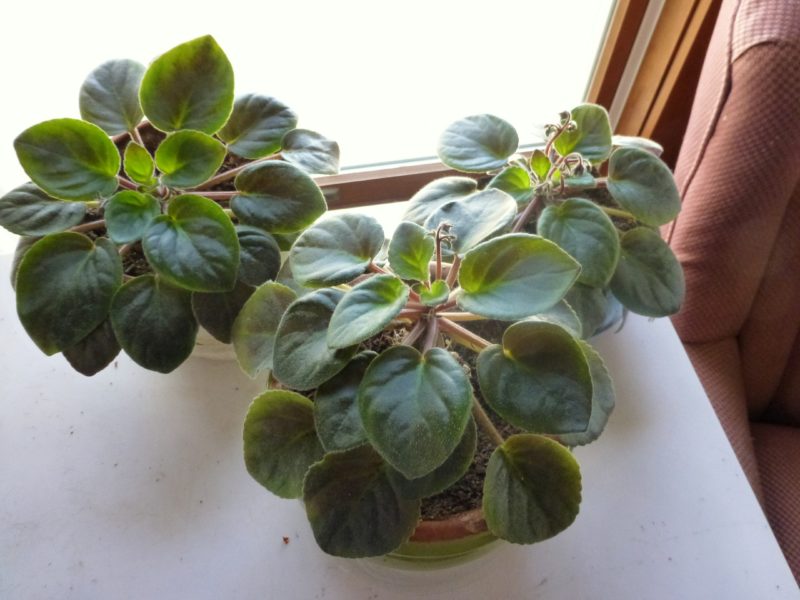
Shine. Lack of light is a common cause, lack of flowering in violets. Improperly located flowers in the apartment suffer from a lack of light. It is easy to find out if you look at the foliage of a plant; it always stretches upward. But the sun is also contraindicated in violets, otherwise burns will appear on the foliage.
For abundant flowering, these indoor plants need 12 hours of continuous lighting every day.
Fertilizers During plant nutrition, it is impossible to use mainly nitrogen compounds, since this contributes to the active growth of the green part, and the formation of flowers will be delayed. If there is an excess of potassium in the fertilizer, then the violet may stop growing and turn yellow.
Water. There may be no flowers on the plant due to improper watering. Do not allow the complete drying of the soil and waterlogging, as well as the use of hard, cold water.
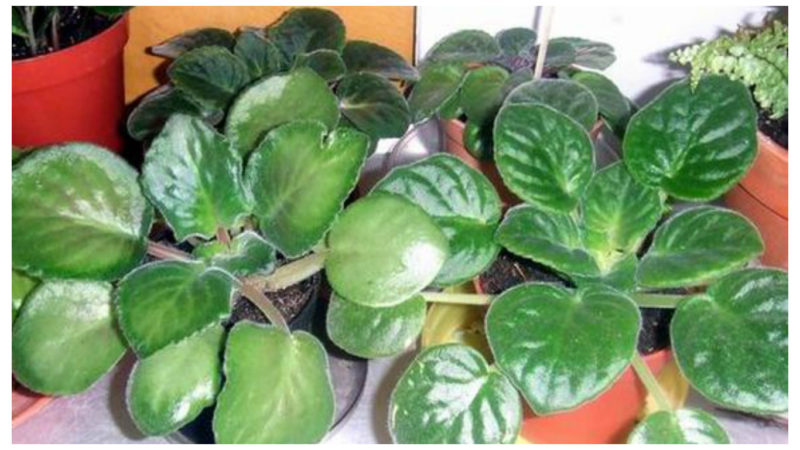
Air humidity. In ordinary city apartments, especially during the heating season, air humidity is only 20-30%, while violets need 50% for normal development. Therefore, it is worth installing a saucer with wet expanded clay next to the flower.
Priming. Normal soil from the garden will not work. It is important that it is light, well breathable. But over time, the best soil can clump, so once a year or a half, the plant needs a transplant.
Capacity. Flowers may not appear at all if the violet is planted in a large flowerpot.
Age. If the plant is more than three years old, then most likely it will not bloom. Violets bloom on young outlets at the age of 1-3 years. They renew the violet in the winter, planting daughter sockets, by the spring it will adapt and bloom.
Plant diseases and pests
Signs of infection or the presence of parasites can be noticed even by a beginner grower. Such negative effects can be the reason for the lack of colors.
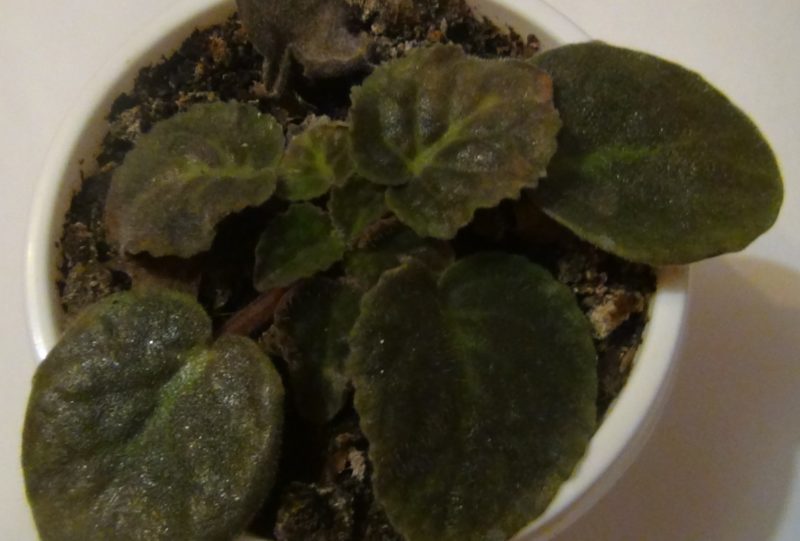
Disease
- Powdery Mildew Infection occurs with insufficient light, air temperature less than +18 degrees, dusty room. Powdery mildew looks like white bloom on the stems of a plant. Wipe the stalks of the violets with a slightly damp cloth, ventilate the room, and use the Benlat preparation.
- Gray rot. It arises due to temperature differences, frequent watering with cold water. It looks like a gray, fluffy coating on the petioles and leaves of violets. For treatment, “thiram”, “phytosparin”, “agate” and other fungicides are used.
- Fusarium This fungus leads to decay of the root system, it occurs due to improper care (frequent watering, cold water). The plant does not bloom, the foliage turns gray and falls off. For treatment and prevention use a solution of benomyl, fundozole.
Insects - pests often found on violets
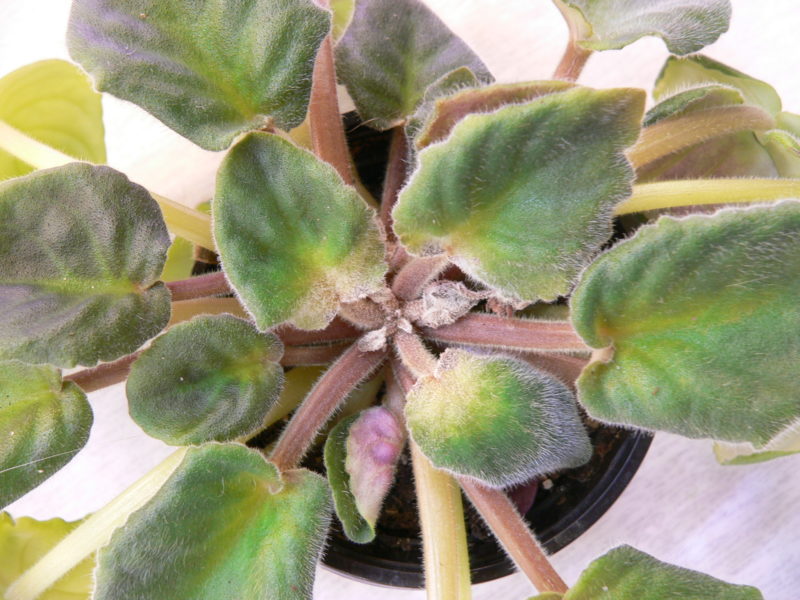
- Ticks Red dots with spider webs on the leaves indicate damage by a spider mite. On young leaves in the center of the flower is a cyclamen tick; traces of its activity are round yellow spots. In this case, the plants are treated with an actellic.
- Aphid. These insects can get into the apartment with flowers brought from the cottage or with an acquired seedling. Aphids drink juice from a plant, affecting buds and flowers. If insects are found, a solution of mospilan or actellik is used.
- Worms. The plant is covered with small red spots, insects are easy to notice if you remove the plant from the pot. Violet is sprayed with phytoderm, the roots are cleaned of soil and sprayed with actar.
In order for the violet to please with good and long flowering, it is necessary to observe the conditions of detention, properly care for and from time to time check the plant for the presence of pests.












